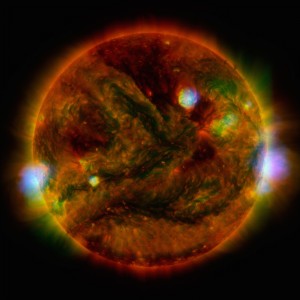Below are research project which have been previously offered within the Astronomy & Astrophysics group. Most are suggested project topics without funding necessarily available and will evolve over time. Some may not be available for the 2026 round. There is a range of competitive scholarship funding and more information is available on the college website.
- Solar energetic electrons from the Sun to the Earth
- Chromospheric observations of Solar Flares – Studies with IRIS
- Optical studies of solar flares
- Diagnostics of solar particle acceleration – a cosmic prototype
- Particles, Plasma and Electromagnetic Waves in the Heliosphere
- Energetics of small solar flares
- Pulsar Magnetospheres
- Cosmic Magnetism and Plasma Cosmology
- Plasma Sheath stability and plasma acoustics
- Surface flow induced ionization in the Sun
- Self-consistent dust growth in plasmas
- Lightning in the atmosphere of brown dwarfs and exoplanets
- Dust cloud evolution in sub-stellar atomspheres
- Plasma for environmental applications
In addition there is a project funded via Dr. Graham Kerr’s Royal Society University Research Fellowship on Solar Flare Fine-Scale Structure: The role of the pre-flare atmosphere.
More details about PhDs and the applications process are available on The College of Science and Engineering Graduate School webpages – which links through to the application webpage for PGR in Physics & Astronomy. Students need to indicate the project title or area they would like to work in and supervisor. So, the prospective students should first contact the supervisor concerned for more details of the projects, particularly to determine whether they are available for a potential project.
The current deadline for applications is Monday February 16th 2026 – please contact us for more information and details of potential funding.
Solar Flare Fine-Scale Structure: The role of the pre-flare atmosphere
Supervisor: Dr Graham Kerr (contact Graham.Kerr.2@glasgow.ac.uk)
Solar flares perturb the whole solar atmosphere, rather dramatically in the chromosphere and transition region where enhancements to the Sun’s radiation takes the form of large-scale ribbon structures. That radiation presents a diagnostically useful window on the energy release and transport processes taking place during flares. Within those flare ribbons we now know there exists substantial sub-structure. Variations in the intensity, and other properties of both spectral lines and continua are present on scales smaller than 1”. Efforts to explain the origin of this fine-scale structure in terms of small-scale differences in energy transport properties has been fruitful. However, the inherent inhomogeneous nature of the underlying atmosphere into which that energy flows undoubtedly plays an important role. This has been little explored.
This PhD project will explore the role of the pre-flare atmosphere in producing the variations observed along flare ribbons. Both observational analysis and numerical modelling approaches will feature, though the overall emphasis of each technique can be guided by the candidate’s preference and experience. Data sources include high-resolution observations from NASA’s Interface Region Imaging Spectrograph (IRIS), and NASA/ESA’s Solar Orbiter, and the Daniel K. Inouye Solar Telescope (DKIST). Modelling resources include the RADYN, RH, and STiC numerical models. The work will also make predictions for future missions like NASA’s Multi-slit Solar Explorer (MUSE), to be launched in 2027. The potential exists for collaborations between colleagues in Europe or the USA, including NASA Goddard Space Flight Center, the University of Oslo, and Stockholm University.
The candidate should have a previous degree in physics, astronomy or mathematics and ideally have some programming experience (particularly in Python, but IDL, C and Fortran would also useful).
This project is funded via a Royal Society University Research Fellowship, covering stipend for 4 years, commensurate with the UKRI rate, fees for a UK student, and research expenses (travel and computing).
Solar energetic electrons from the Sun to the Earth
Supervisor: Prof Eduard Kontar

Solar flares are efficient in electron acceleration, so that plasma particles are boosted to high speeds in the corona and can escape into the interplanetary space. The solar flare electrons can travel from the Sun to near Earth and can be directly observed by spacecraft near Earth or via radio emission in the inner heliosphere. Flaring activity on the Sun can directly impact communication systems, power networks and near Earth satellites. So, understanding of these energetic particles and related electromagnetic emissions is of practical importance and is an important component of space weather.
With the launch of ESA/NASA Solar Orbiter, Parker Solar Probe, the observations of these energetic particles closer to the Sun become possible. While the forthcoming SunRISE experiment, will create detailed 3D maps of where energetic radio emissions occur in the heliosphere. Building on these unprecedented observations, the project aims to extend the current understanding of the electron beam transport from the Sun to the Earth and to predict the arrival of solar energetic electrons over broad energy range. For the first time, a model tested by the in-situ observed electron, X-ray and radio data will be constructed.
Chromospheric observations of Solar Flares – Studies with IRIS
Supervisor: Prof Lyndsay Fletcher
Solar flares are identified by strong radiation increases across the electromagnetic spectrum, but especially in radiation from the solar chromosphere. This research project will focus on understanding the properties of the solar flare chromosphere during the rapid burst of emission that occurs at the flare onset (the impulsive phase) and also during the slower evolutionary phase that follows as the solar atmosphere adjusts towards a new equilibrium. The project will involve the use of data from the Interface Region Imaging Spectrometer (IRIS), supported by the Solar Dynamics Observatory, to diagnose the properties of the intense, hot sources of flare emission. Topics for the proposed study include:
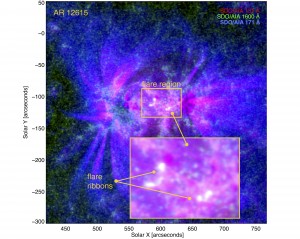
Carrying out spectroscopic analyses of the emission from flare footpoints and ribbons to look at the dynamics of these regions at different stages of the flare;
Understanding the horizontal and vertical structuring of the flare footpoint and ribbon emission;
Determining the relationship between the fine-scale spatial structures in the flare emission and the pre-flare atmosphere, and between the flare emission and the underlying magnetic field
The project will utilise high resolution data from a number of spacecraft, and involves programming in Python or IDL. Depending on the interest of the student, numerical modeling in collaboration with colleagues from Oslo is also a possibility.
Optical studies of solar flares
Supervisor: Prof Lyndsay Fletcher
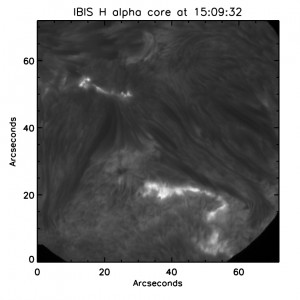
Solar flares are dramatic bursts of particles and radiation from the solar atmosphere produced when energy is released suddenly from the coronal magnetic field. Although flares have a very beautiful appearance at short wavelengths (extreme UV and X-rays), the majority of the flare radiation is emitted in the optical part of the spectrum, which is thus a region rich in diagnostic information. This project will focus on the analysis of ground-based solar flare observations, taken with the Swedish Solar Telescope and other ground-based instruments. Possible research topics include
- Optical line plasma diagnostics – e.g. using high-order Balmer lines to determine the electron density and its evolution through a flare;
- Spatial and temporal characterisation of H-alpha and Ca 8542 emission, including spectropolarimetry and comparison with model predictions;
- Examination of the magnetic field variations at the location of flare optical emission.
The project will utilise high resolution data from ground-based instruments (but may also involve Solar Optical Telescope on the Hinode satellite), and involves programming in Python and IDL. Depending on the interest of the student, numerical modeling in collaboration with colleagues from Oslo is also a possibility.
Diagnostics of solar particle acceleration – a cosmic prototype
Supervisors: Prof Eduard Kontar, Dr Iain Hannah and Prof Lyndsay Fletcher
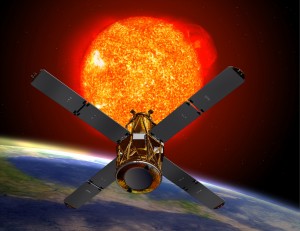
Particle acceleration is a ubiquitous cosmic phenomenon from the scale of active galactic nuclei down to planetary magnetospheres with the resulting fast particles having an energy density high enough to influence their environment. Acceleration processes are far from well understood, either theoretically or phenomenologically from data interpretation.
The nearby sun offers a unique opportunity to study particle acceleration via high resolution spectra and images at radio to gamma-ray wavelengths from ground and space observatories, and by direct particle detection in space. We were the UK Co-I Group on the NASA high energy RHESSI solar mission and involved with ESA’s Solar Orbiter mission, Glasgow is involved in a wide range of theoretical and numerical projects on diagnosing data on solar electron and ion acceleration.
Possible thesis topics include:
- data mining and reduction;
- signal analysis (spectrum and image deconvolution);
- tests of phenomenological models against data;
- numerical simulations and analytic modelling
Particles, Plasma and Electromagnetic Waves in the Heliosphere
Supervisors: Prof Eduard Kontar and Prof Lyndsay Fletcher
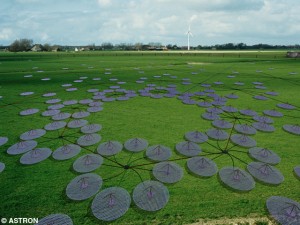
The physics of the solar system plasma in the near-Sun environment and further into space – the heliosphere – is studied by means of in-situ observations of particles and fields and low frequency radio emission and supported by theoretical calculations of the plasma wave, wave-particle and particle transport processes that link the Sun to space.
We have close involvement with instruments and missions designed to study the heliospheric environment and can offer a range of theoretical projects, with supporting observations, e.g.:
- Physics of wave-wave and wave-particle interaction in the heliosphere
- Wave acceleration of particles in solar flares
- Coherent plasma emission from energetic particles, plasmas and shock waves
- Development of solar radio emission models for the next generation of solar radio observatories (e.g. LOFAR – The Low Frequency Array for Radio astronomy, and FASR – the Frequency Agile Solar Radio telescope)
Studying the energetics of small solar flares
Supervisors: Dr Iain Hannah
Solar flares are rapid releases of energy in the solar atmosphere and the energetically smaller the flare the more frequently they occur. These microflares, and heading down to the postulated nanoflares scale (about a billionth the energy of the biggest flares), could contribute significantly to the heating of the solar atmosphere. If these small events involve the same physical process as the large events then they should also accelerate particle as well.
Projects studying these small flares require highly sensitivity observations of the Sun’s atmosphere and recent work has used the unique X-ray observations from NASA’s astrophysics telescope NuSTAR in comparison to data from solar X-ray/EUV /UV telescopes like Solar Orbiter/STIX, Hinode/XRT, SDO/AIA and IRIS.
Pulsar Magnetospheres
Supervisor: Prof Declan Diver
Pulsar atmospheres consist of electron-positron plasmas. Such plasmas are very energetic, and given that the positive and negative species have equal mass, these plasmas have unique properties. We are investigating wave propagation in magnetised pair plasmas, from the perspective of trying to understand the wave processes that could contribute to the pulsar radiation source. To date we have examined the radiation damping of quasi-linear electron-positron plasma oscillations, using computer simulations. Complex analysis has allowed us also to reformulate the Bernstein modes in a weakly relativistic pair plasma, with a view to studying how such weakly damped magnetic modes might act as a vehicle for radiation transport in a non-uniform plasma.
The project will be concerned with:
- developing simulations of the interaction between fast particle streams and large-amplitude collective oscillations;
- extending our analytical attack on relativistic Landau damping, and exploiting the new physics that arises; and
- creating the necessary relativistic transformations that allow the radiation field to be translated into the observer’s frame.
Cosmic Magnetism and Plasma Cosmology
Supervisor: Dr Declan Diver
The role of the magnetic field in medium scale cosmic evolution is not well understood, given the complexity of the possible interactions. We aim to focus on two specific areas: (1) the natural evolution of jets and other linear structures, and (2) the development of density structure in large-scale mixed flows of plasma and neutrals.
- Self-guiding magnetic fields, produced by Inverse Faraday Rotation( in which the internal plasma currents create an axial magnetic field component that is projected ahead of the plasma front, so guiding the direction of the flow could play a role in the evolution of large-scale astrophysical jets, in which rectilinear structures stretch for remarkably large distances with very little deviation
- Plasma-neutral gas mixtures are a unique medium, if momentum transport is incorporated between the charged fluid and its neutral counterpart. Density structures evolve that are hybrids of the plasma response to magnetic perturbations, and the neutral gas sonic pressure waves. The resulting mixture leads to an anisotropic medium that can support a large variety of pressure variations
Plasma Sheath stability and plasma acoustics
Supervisor: Prof Declan Diver
A project to model (i) the impact that a plasma source can have on neutral gas and (2) the time evolution of the sheath around a free-surface in a streaming plasma.
- In plasma acoustics, the ion wind and localised heating of a plasma source in a neutral gas can trigger significant sonic disturbances.
- In the sheath stability studies, the electrostatic environment at the perimeter of a possibly deformable conducting (or dielectric) structure placed directly in a flowing plasma.
These projects are computational and analytical in character, sharing basic plasma physics but applied to different situations. Several competing scale-lengths will contribute to the complexity of the evolution: the collisional mean free path of the plasma, the free-fall sheath length scale, the typical wavelength of deformation of the conductor and the scale-length for non-uniformity of the plasma flow. The competition between these characteristic scales will lead to strong time-dependence in the local electric field, and the consequence non-linear feedback on both the impinging plasma flow, sonic disturbances and the free-surface deformation of the obstruction.
Surface flow induced ionization in the Sun
Supervisor: Prof Declan Diver
A numerical and theoretical investigation of Alfven ionization processes in strong solar photospheric flows. The kinetic energy of mixed-species neutral gas flowing through a magnetised plasma can result in pockets of energetic plasma electrons (confined by the magnetic field) that are able to ionize specific neutrals in the flow via electron-impact ionization. Such a process has already been implicated in creating the anomalous chemical composition of the solar wind; we aim to extend this study by correlating solar surface flows and magnetic structures together with improved data on solar abundances to clarify the overall picture of ionised species evolution in the magnetic environment of the sun.
Specifically, this project will address:
- the creation and transport of particular ions via interaction with a defined magnetic structure,
- the investigation of the differential diffusion of minority species in order to model directly the resulting abundance anomalies in the solar wind.
This will allow us to incorporate time-dependence arising from the photospheric flows and the character of the magnetic structures, as well as processes on solar cycle timescales
Self-consistent dust growth in plasmas
Supervisor: Prof Declan Diver
The evolution and character of plasma dust has wide-ranging implications for astrophysics and laboratory plasmas, including fusion and plasma processing.
Whilst there are many studies of plasma crystals, there are fewer investigations of the more profound problem of growing the dust from first principles directly in the plasma. Classical condensation mechanisms are not as relevant in the plasma context, since in the latter the local electrostatic conditions can influence enormously the conditions for dust growth, leading in some cases to naturally occurring prolate-spheroidal dust shapes. The implications of non-spherical dust grains for electromagnetic extinction and polarisation in astronomical observations are well-known, but though progress has been made in characterising the effects of composite grain structure and spheroidal shapes, there is little in the way of a holistic approach to the problem.
The main aims of this project are:
- To model the formation and evolution of dust in the original supporting plasma;
- To examine the electrostatic charging of dust over a range of scales, and its subsequent growth, with and without a magnetic field
- To simulate the remote diagnosis of the medium
Lightning in the atmospheres of brown dwarfs and exoplanets
Supervisor: Dr Craig Stark
Brown Dwarfs (BD) are intriguing astronomical objects; being neither stars nor planets, they straddle the poorly understood transition from cool stars to giant gas exoplanets. Their mass is insufficient to sustain hydrogen fusion resulting in very cool magnetized atmospheres and the formation of dust clouds. Triboelectric charging of the dust particles can result in a population of electrically active dust grains leading to large-scale electrical discharges or smaller-scale inter-grain sparking. Such ionization events inject a population of free electrons, ions, excited species, radicals and metastables into the local environment potentially lowering the activation energy barrier and enhancing reaction rates for surface reactions to occur, triggering a set of chemical reactions otherwise energetically unavailable.
This project aims to simulate lightning in BD atmospheres to help characterise large-scale electrical discharges and to quantify the impact of such events on cloud chemistry in substellar atmospheres.
The principal objectives are to:
- simulate the electron avalanche and streamer stages of electrostatic discharges for a range of atmospheric parameter regimes in BD atmospheres;
- model the resultant plasma-activated plasma chemistry and its impact on the atmosphere.
Dust cloud evolution in sub-stellar atmospheres
Supervisor: Dr Craig Stark
Understanding the formation, growth, and destruction of dust, leading to the evolution of large-scale cloud structures in sub-stellar atmospheres is key to interpreting their electromagnetic spectra and characterising their role in the transition between L and T dwarfs. In contemporary sub-stellar model atmospheres, dust growth occurs through neutral gas-phase surface chemistry. Recently, there has been a growing body of theoretical and observational evidence suggesting that ionisation processes can occur. As a result, atmospheres are populated by regions composed of plasma, gas and dust, and the consequent influence of plasma processes on dust evolution is significant.
The aim of this project is to investigate the influence of plasmas on dust growth, destruction, and evolution in sub-stellar atmospheres.
The principal objectives are to:
- model gas-plasma chemistry and surface interactions leading to mantle growth, molecule production and its impact on spectra;
- simulate the plasma-dust-surface interactions leading to surface energy enhancement and its effect on water absorption and adhesion of metals as a function of atmospheric pressure;
- model the fragmentation of charged dust grains via electrostatic disruption, and so impact on cloud seeding via amended seed distributions.
Plasmas for environmental applications
Supervisor: Dr Craig Stark
As pressure mounts to find solutions to outstanding environmental challenges such as the long-term storage of atmospheric carbon dioxide or micro-plastic pollution reduction, new technologies are required to help curb their devastating effects on the environment. Plasma processes may present novel solutions to such challenges and help contribute towards the necessary portfolio of technologies required to safeguard the environment. Carbon sequestration is a crucial technological step towards finding a solution for the long-term storage of atmospheric carbon dioxide to help mitigate climate change. Micro-plastics could be potential carbon getters, reacting with activated carbon dioxide via plasma catalysis or plasma polymerisation and making the micro-plastics more reactive relative to other chemical filters. This approach exploits existing pollutants enabling micro-plastic pollution reduction, a growing environmental challenge, whilst simultaneously sequestering carbon.
The aim of this project is to explore and quantify the process of plasma catalysis-enhanced carbon sequestration in a plasma containing micro-plastics (a dusty plasma).
The principal objectives are to:
- model the key gas-plasma chemistry for sequestering carbon;
- simulate the electrostatic activation of chemistry due to charged dust interactions;
- simulate the critical surface interactions and gas-plasma-particulate symbiosis, incorporating carbon acquiring micro-plastics.
To discuss further your interests, please contact group members directly with any questions.
